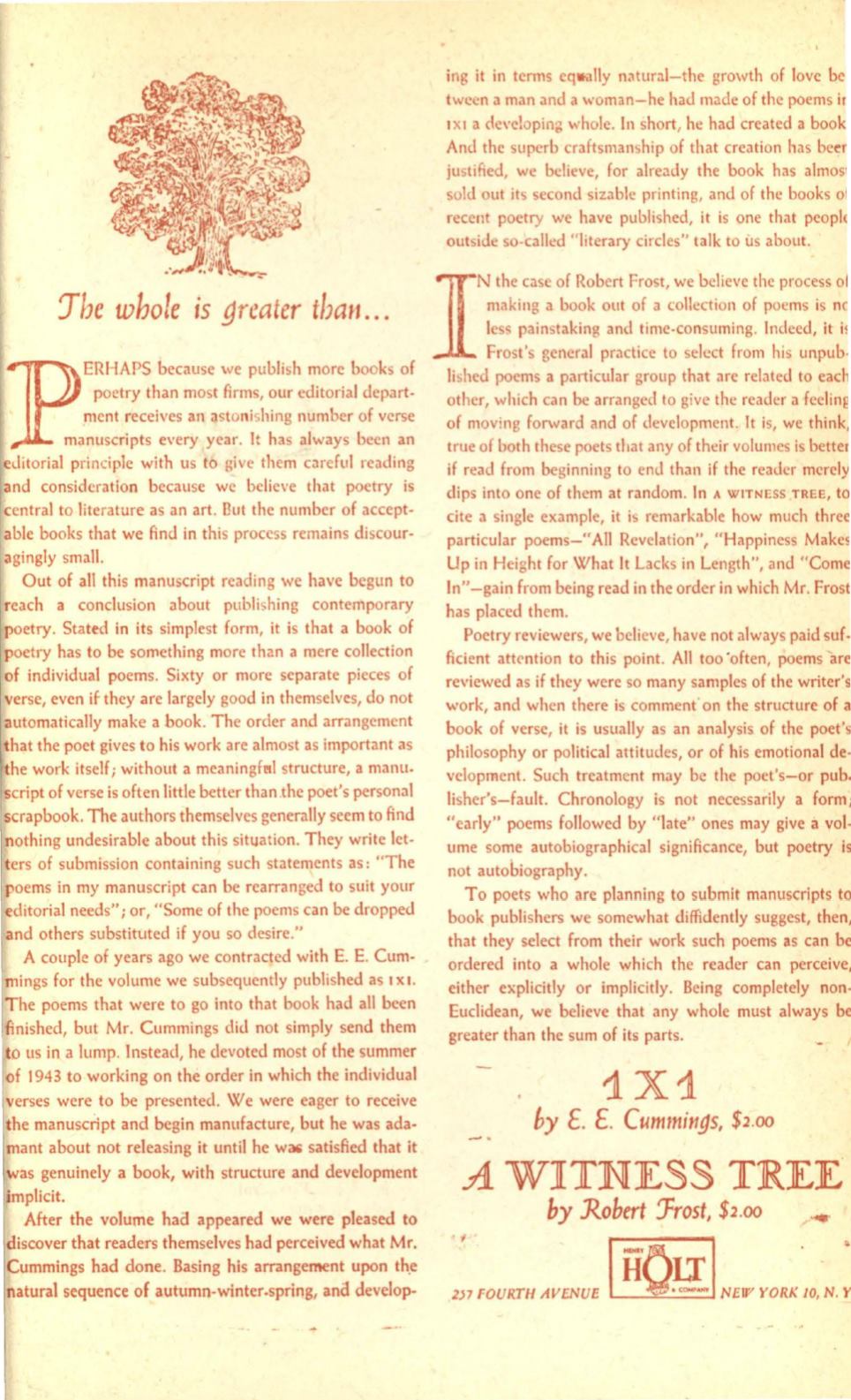
J'he whole is greater tl;an ...
P
ERHAPS because we publish more books of
poetry than most firms, our editorial depart–
ment receives an astonishing number of verse
anuscripts every year. It has always been an
editorial principle with us to give them careful reading
and consideration because we believe that poetry is
central to literature as an art. llut the number of accept–
able books that we find in this process remains discour–
agingly small.
Out of all this manuscript reading we have begun to
reach a conclusion about publishing contemporary
poetry. Stated in its simplest form, it is that a book of
poetry has to be something more than a mere collection
of individual poems. Sixty or more separate pieces of
verse, even if they are largely good in themselves, do not
automatically make a book. The order and arrangement
that the poet gives to his work are almost as important as
the work itself; without a mcaninghtl structure, a manu.
script of verse is often little better than .the poet's personal
scrapbook. The authors themselves generally seem to find
nothing undesirable about this situation. They write let–
ters of submission containing such statements as : "The
poems in my manuscript can be rearranged to suit your
ditorial needs"; or, "Some of the poems can be dropped
and others substituted if you so desire."
A couple of years ago we contracted with E. E. Cum–
mings for the volume we subsequently published as 1xI.
The poems that were to go into that book had all been
finished, but Mr. Cummings did not simply send them
to us in a lump. Instead, he devoted most of the summer
of
1943
to working on the order in which the individual
verses were to be presented. We were eager to receive
the manuscript and begin manufacture, but he was ada–
mant about not releasing it until he
Willi
satisfied that it
as genuinely a book, with structure and development
mplicit.
After the volume hao appeared we were pleased to
discover that readers themselves had perceived what Mr.
ummings had done. Basing his arrangement upon th.e
atural sequence of autumn-winter-spring, and develop-
ing it in terms cqilillly natural-the growth of love be
tween a man and a woman-he had made of the poems ir
1x1a developing whole. In short, he had created a book
And the superb craftsmanship of that creation has beer
justified, we believe, for already the book has almost
sold out its second sizable printing, and of the books ol
recent poetry we have published, it is one that peoplt
outside so-called "literary circles" talk to us about.
I
N
the case of Robert Frost, we believe the process ol
making a book out of a collection of poems is nc
less painstaking and time-consuming. Indeed, it i!
Frost's general practice to select from his unpub·
lished poems a patiicular group that are related to each
other, which can be arranged to give the reader a feeling
of moving forward and of development.
It
is, we think,
true of both these poets tltat any of their volumes is better
if read from beginning to end than if the reader merely
dips into one of them at random. In
A
WITNEss TREE, to
cite a single example, it is remarkable how much three
particular poems-" AII Revelation", "Happiness Makes
Up in Height for What
It
Lacks in Length", and "Come
In"-gain from being read in the order in which Mr. Frost
has placed them.
Poetry reviewers, we believe, have not always paid suf
ficient attrntion to this point. All too ·often, poems are
reviewed as if they were so many samples of the writer'
work and when there is comment' on the structure of
book, of verse, it is usually as an analysis of the poet'
philosophy or political attitudes, or of his emotional de
velopment. Such treatment may be the poet's-or pub
lisher's-fault. Chronology is not necessarily a form
"early" poems followed by "late" ones may give
a
vol
ume some autobiographical significance, but poetry i
not autobiography.
To poets who are planning to submit manuscripts t
book publishers we somewhat diffidently suggest, then
that they select from their work such poems as can b
ordered into a whole which the reader can perceive
either explicitly or implicitly. Being completely non
Euclidean, we believe that any whole must always b
greater than the sum of its parts.
1X1
by E. E. Cummings,
$2.oo
A
WITNESS
TREE
by Robert ::Frost,
$2.0o
,...,.
• f
0
•
-
2>7 FOURTH AVENUE
NElli' YORK 10, N.


